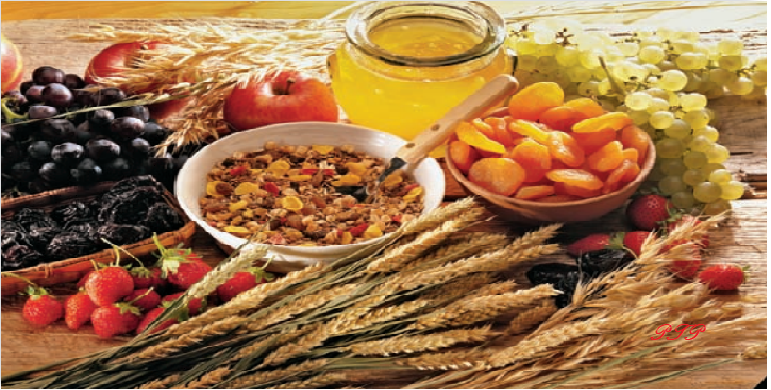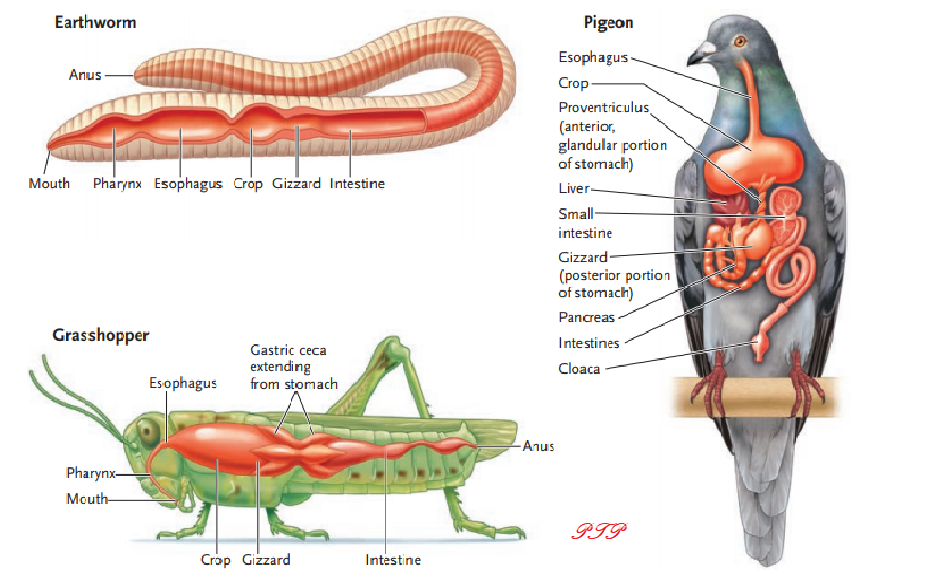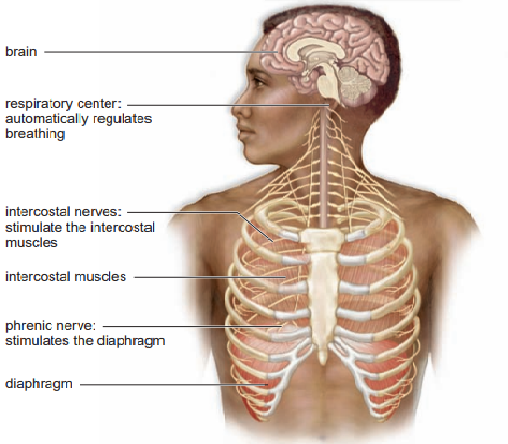Essay Questions on Digestive and Respiratory Systems (SHS Biology) for Revision.

Essay Questions on Digestive and Respiratory Systems (SHS Biology) for Revision.
Digestive System

1. A complete digestive tract can have many specialized parts. Explain.
When a digestive tract has both a mouth and anus, each part of the tract can become specialized as in the earthworm where the pharynx, crop, gizzard, and intestine have specialized functions.
2. Compare the teeth of carnivores to those of herbivores.
- Carnivores tend to have pointed incisors and enlarged canine teeth to tear off pieces small enough to quickly swallow.
- The molars are jagged for efficient chewing of meat. Herbivores have reduced canines but sharp even incisors to clip grasses.
- The large flat molars grind and crush tough grasses.
3. Trace the path of food from the mouth to the large intestine.
- Mouth,
- pharynx,
- esophagus,
- stomach,
- small intestine,
- large intestine,
- rectum, and
- anus.
4. What are the functions of the small intestine, and how is the wall of the small intestine modified to perform these functions?
- The small intestine finishes the digestion of proteins, fats, carbohydrates, and nucleic acids.
- Bile from the liver (emulsifies fat) and pancreatic juice assist digestion, but so do the brush-border enzymes because they are on the microvilli extending from intestinal villi.
- The villi and microvilli greatly enhance the surface area of the intestinal wall, thereby assisting the small intestine’s second function: absorption of the final products of digestion.
5. What are the three main accessory organs that assist with the digestive process?
- The pancreas,
- The liver, and
- The gallbladder.
6. How does each accessory organ contribute to the digestion of food?
- Pancreatic juice, which enters the duodenum, contains pancreatic amylase for the digestion of starch, trypsin for the digestion of protein, and lipase for the digestion of fat.
- The liver makes bile, which is stored in the gallbladder.
- Bile enters the duodenum where it emulsifies fat preparatory to its digestion by lipase.
- Also, the liver has many other functions, such as the storage of glucose as glycogen.
7. Describe the breakdown and absorption of starch and protein.
- Starch digestion begins in the mouth where salivary amylase digests starch to maltose and pancreatic amylase continues this same process in the small intestine.
- Maltase and brush-border enzyme digests maltose into glucose, which enters a blood capillary.
- Protein digestion starts in the stomach where pepsin digests protein to peptides and continues in the small intestine where trypsin carries out this same process.
- The intestinal enzyme called peptidase digests peptides to amino acids, which enter a blood capillary.
8. Why is a diet that includes plentiful vegetables better for you than a diet that includes excess protein?
- Vegetables, if properly chosen, can supply limited calories but all necessary amino acids and vitamins.
- Much urea results when excess amino acids from proteins are metabolized.
- The loss of water needed to excrete urea can result in dehydration and loss of calcium ions.
9. How can you decrease your chances of acquiring type 2 diabetes and cardiovascular disease?
- Eat well-balanced meals (limit saturated fats and instead consume unsaturated fats).
- Keep body weight within the normal range and exercise regularly.
10. How is pepsin produced? What is its function?
- Pepsin is secreted from chief cells into the stomach lumen as an inactive precursor molecule, pepsinogen.
- The pepsinogen is converted to pepsin by the highly acidic conditions of the stomach.
- Pepsin is a digestive enzyme that begins the digestion of proteins by making breaks in polypeptide chains.
11. Distinguish between the functions of the small and large intestines in the process of digestion.
- In the small intestine, the digestion of macromolecules into their molecular subunits occurs, and those subunits are absorbed.
- In the large intestine, water and mineral ions are absorbed from the remaining digestive contents, leaving the undigested remnants, the feces, which are expelled from the body.
12. How are the different types of teeth used in feeding?
- Incisors nip or cut food.
- Canines bite and pierce food.
- Premolars and molars crush, grind, and shear food.
13. What roles do symbiotic microorganisms play in digestion?
- Symbiotic microorganisms aid digestion in many herbivores by assisting in the breakdown of plant material.
- The microorganisms synthesize cellulase, an enzyme vertebrates cannot make, which hydrolyzes the cellulose of plant cell walls into glucose subunits.
- Mutualistic microorganisms that synthesize essential amino acids and vitamins, and digest particular components of food that otherwise are indigestible, are found in the gut microbiomes of all mammals.
14. What differentiates the consequences of the secretion of gastrin and cholecystokinin (CCK)?
- Gastrin stimulates the secretion of pepsinogen and HCl in the stomach.
- Pepsin generated by cleavage of pepsinogen digests protein in the swallowed food.
- Gastrin also stimulates contraction of the stomach and the intestines.
- Cholecystokinin (CCK), released in the duodenum in response largely to the fat content in chyme, inhibits gastric activity; that is, CCK has the opposite effect of gastrin.
15. What are essential nutrients, and are they the same for all animals?
- Essential nutrients are the amino acids, fatty acids, vitamins, and minerals that the animal cannot make itself and must obtain from its diet.
- The list of essential nutrients varies among animal types.
16. What is the difference between deposit feeders and suspension feeders?
- Deposit feeders pick up or scrape particles of organic matter from solid material they live in or on.
- Suspension feeders ingest small organisms that are suspended in water.
- Depending on the animal, the ingested organisms may be bacteria, protozoa, algae, small crustaceans, or fragments of those organisms.
Respiratory system

1. Explain the process of inspiration and expiration in humans.
- During inspiration, the rib cage moves up and out, and the diaphragm contracts and moves down.
- As the thoracic cavity expands, air flows into the lungs due to decreased air pressure in the lungs.
- During expiration, the rib cage moves down and the diaphragm relaxes and moves up to its former position.
- Air flows out as a result of increased pressure in the lungs.
2. What are two key advantages of air over water as a respiratory medium?
Two key advantages of air over water as a respiratory medium are:
- there is much more oxygen in the air than in water; and
- air is much less dense and less viscous than water, so significantly less energy is needed to move air over the respiratory surface than to move water.
3. Describe the functions of haemoglobin in the transport of O2 and CO2.
- In the lungs, oxygen entering pulmonary capillaries combines with haemoglobin (Hb) in red blood cells to form oxyhemoglobin (HbO2).
- In the tissues, Hb gives up O2. CO2 enters the blood and the red blood cells.
- Some combine with Hb to form carbaminohemoglobin HbCO2.
- Most CO2 combines with water to form carbonic acid, which dissociates into H+ and HCO3.
- The H+ is absorbed by the globin portions of haemoglobin to form reduced haemoglobin Hb H+.
- This helps stabilize the pH of the blood. The HCO3- is carried in the plasma.
4. What advantages do gills confer on a water-breathing animal over skin-breathing?
The advantages of gills to water-breathing animals over skin breathing are greater efficiency of gas exchange, the ability to live in more diverse habitats, and the potential to achieve a greater body mass.
5. What is a counter-current exchange, and how is it beneficial for gas exchange?
- In counter-current exchange, the respiratory medium flows opposite to the blood flow under the respiratory surface.
- Examples are the flow of water over the gills in sharks, fishes, and some crabs; all these are opposite to the flow of blood.
- The advantage of this mechanism is that it maximizes the amounts of O2 and CO2 exchanged with the respiratory medium.
6. How does the tracheal system of insects facilitate gas exchange with the cells of the body?
- In the tracheal system, fine branches called tracheoles end in tips that are in contact with body cells.
- The tracheole tips are filled with fluid, and gas exchange occurs through the body cells’ fluid and plasma membrane in contact with the tips.
- Air enters the tracheal system through spiracles on the body surface.
- Movement of air through the tracheal system occurs by muscle-driven contractions and expansions of air sacs within the system
7. Distinguish between positive pressure breathing and negative pressure breathing in animals with lungs.
- In positive pressure breathing, gulping, swallowing, or pumping action forces air into the lungs.
- In negative pressure breathing, muscular activity expands the lungs, lowering the pressure of air in the lungs and thereby causing air to be pulled inward.
8. Why is carbon monoxide potentially lethal?
- CO has a much greater affinity for hemoglobin than does O2, and so it displaces O2 from hemoglobin, reducing the amount of O2 carried in the blood.
- Because the brain does not monitor O2 levels, and other receptors do not respond until blood O2 levels are critically low, victims can easily lapse into unconsciousness and death.
9. What are the key evolutionary adaptations that diving mammals use to survive at significant ocean depths?
- More blood per unit body weight than land animals
- Additional red blood cells, many stored in the spleen and released during a dive
- More myoglobin in muscles than in land animals
- Slowing of the heart by as much as 90%
- Reduction of blood circulation to internal organs and muscles by up to 95%
- Retention of lactic acid in the muscles with no release into the blood until the animal returns to the surface
Join Enlighten Knowledge WhatsApp Channel.
Join Enlighten Knowledge Telegram platform.






